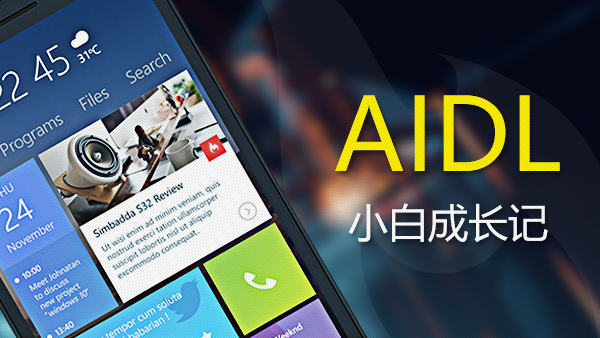Android的消息机制主要是指Handler的运行机制,通过Handler可以轻松的将一个任务切换到Handler所在的线程中执行.
概述
将Handler用于UI更新:
有时候需要在子线程中进行耗时的IO操作,当耗时操作完成后可能需要在UI上做一下变化,因为Android开发规范限制,我们不能在子线程中访问UI控件,否则会出发程序异常(ANR 无响应),此时通过Handler就可以将更新UI的操作切换到主线程中执行.
//Android在ViewRootImpl中进行UI操作验证.
void checkThread() { if (mThread != Thread.currentThread()) { throw new CalledFromWrongThreadException( "Only the original thread that created a view hierarchy can touch its views.");
}
}不允许在子线程更新UI操作的原因:
Android的UI控件不是线程安全的,如果在多线程中并发访问可能会导致UI控件处于不可预期的状态.
那么为什么系统不对UI控件的访问加上锁机制呢.其实有两点:
加上锁机制会使得UI访问逻辑变得复杂
锁机制会降低UI访问的效率,因为锁机制会阻塞某些线程执行.
Handler的执行流程
Handler创建完毕后,通过Handler的postXX()方法将一个Runnable传递到Handler的内部的Looper中去处理.
public final boolean post(Runnable r){...} public final boolean postAtTime(Runnable r, long uptimeMillis){...} public final boolean postAtTime(Runnable r, Object token, long uptimeMillis){...} public final boolean postDelayed(Runnable r, long delayMillis){...} public final boolean postDelayed(Runnable r, Object token, long delayMillis){...} public final boolean postAtFrontOfQueue(Runnable r){...}也可以通过Handler的sendXX()方法发送一个消息,这个消息同样会在Looper中处理.
public final boolean sendMessage(Message msg){...} public final boolean sendEmptyMessage(int what){...} public final boolean sendEmptyMessageDelayed(int what, long delayMillis){...} public final boolean sendEmptyMessageAtTime(int what, long uptimeMillis){...} public final boolean sendMessageDelayed(Message msg, long delayMillis){...} public boolean sendMessageAtTime(Message msg, long uptimeMillis){...} public final boolean sendMessageAtFrontOfQueue(Message msg){...}在这个过程中,其实postXX()方法内部最后也是调用的sendXX()方法来完成的.因此我们就分析一下sendXX()方法的调用过程.
当Handler的sendXX()方法被调用时,会执行enqueueMessage方法将这个消息放入队列中,然后Looper发现有新消息到来时,就会处理这个消息.
//Handler中的
private boolean enqueueMessage(MessageQueue queue, Message msg, long uptimeMillis) {
msg.target = this; if (mAsynchronous) {
msg.setAsynchronous(true);
} return queue.enqueueMessage(msg, uptimeMillis);
}//其内部调用的MessageQueue的enqueueMessage方法.此时,Handler中的业务逻辑就被切换到了创建Handler所在的线程中去执行了(因为Looper运行在创建Handler所在线程).
分析
ThreadLocal
定义
ThreadLocal是一个线程内部的数据存储类,通过它可以在指定的线程中存储数据,数据存储后,只有在指定线程中可以获取到存储的数据.
使用场景
当某些数据是以线程为作用域,并且不同线程有不同的数据副本时,就可以使用ThreadLocal.
比如对于Handler来说,需要获取当前线程的Looper,此时Looper的作用域就是线程,并且不同的线程拥有不同的Looper.复杂逻辑下的对象传递,比如监听器的传递.
有些时候一个线程中的任务过于复杂(函数调用栈较深以及代码入口多样性),这种情况下,我们又需要监听器能够贯穿整个线程的执行过程.此时采用ThreadLocal可以让监听器作为线程内的全局对象而存在,在线程内部只要通过get方法就可以获得监听器.
示例
在不同的线程中使用同一个ThreadLocal对象:
public class CustomActivity extends AppCompatActivity { private static final String TAG = "Sean"; private ThreadLocal<Boolean> mThreadLocal = new ThreadLocal<>(); @Override
protected void onCreate(@Nullable Bundle savedInstanceState) { super.onCreate(savedInstanceState);
setContentView(R.layout.activity_custom);
mThreadLocal.set(true);
Log.d(TAG, "Thread[#main] mThreadLocal=" + mThreadLocal.get()); new Thread("Thread[#1]"){ @Override
public void run() {
mThreadLocal.set(false);
Log.d(TAG, "Thread[#1] mThreadLocal=" + mThreadLocal.get());
}
}.start(); new Thread("Thread[#2]"){ @Override
public void run() {
Log.d(TAG, "Thread[#2] mThreadLocal=" + mThreadLocal.get());
}
}.start();
}
}
...打印结果:2018-11-12 15:04:41.942 18529-18529/? D/Sean: Thread[#main] mThreadLocal=true2018-11-12 15:04:41.943 18529-18565/? D/Sean: Thread[#1] mThreadLocal=false2018-11-12 15:04:41.943 18529-18566/? D/Sean: Thread[#2] mThreadLocal=null可以很清楚的看见,虽然在不同的线程访问同一个ThreadLocal对象,但是获取到的值是不同的.
ThreadLocal的存取机制
我们从数据的存取着手开始分析,首先看保存函数set:
public void set(T value) {
Thread t = Thread.currentThread();
ThreadLocalMap map = getMap(t); if (map != null)
map.set(this, value); else
createMap(t, value);
}首先拿到当前线程实例t,接着通过t获得ThreadLocalMap,我们看到是通过getMap方法获取到的ThreadLocalMap,继续看getMap方法的实现.
ThreadLocalMap getMap(Thread t) { return t.threadLocals;
}getMap方法中直接返回了Thread类中的threaLocals.
ThreadLocal.ThreadLocalMap threadLocals = null;
清楚了各个方法的实现后,我们来捋一捋:
首先ThreadLocal的set方法中,拿到当前线程对象中的ThreadLocalMap对象的实例,其实就是Thread类中的theadLocals.然后将需要保存的值保存到threadLocals中.
说的明显一点就是,每个线程中的ThreadLocal的副本都保存在当前线程Thread对象中,存储结构为ThreadLocalMap,键值的类型分别是当前ThreadLocal实例和传入的内容值.
接下来给获取函数get:
public T get() {
Thread t = Thread.currentThread();
ThreadLocalMap map = getMap(t); if (map != null) {
ThreadLocalMap.Entry e = map.getEntry(this); if (e != null) { @SuppressWarnings("unchecked")
T result = (T)e.value; return result;
}
} return setInitialValue();
}同理,拿到当前线程的对象实例中保存的ThreadLocalMap,然后读取当前ThreadLocal实例所对应的值.
private T setInitialValue() {
T value = initialValue();
Thread t = Thread.currentThread();
ThreadLocalMap map = getMap(t); if (map != null)
map.set(this, value); else
createMap(t, value); return value;
} void createMap(Thread t, T firstValue) {
t.threadLocals = new ThreadLocalMap(this, firstValue);
}通过createMap来创建ThreadLocalMap对象实例,set函数中的ThreadLocalMap实例也是通过createMap生成的.
到此ThreadLocal的存取机制工作流程已经介绍清楚了,并且后续会有文章来详细介绍ThreadLocalMap的存储结构.
MessageQueue工作机制
顾名思义,MessageQueue翻译成中文就是消息队列,它提供的主要两个操作是:插入和读取,对应的方法分别为enqueueMessage和next.
虽然MessageQueue叫消息队列,但是它的内部实现是通过单链表结构来维护消息列表的.
enqueueMessage
作用:往消息队列中插入一条消息.
boolean enqueueMessage(Message msg, long when) { if (msg.target == null) { throw new IllegalArgumentException("Message must have a target.");
} if (msg.isInUse()) { throw new IllegalStateException(msg + " This message is already in use.");
} synchronized (this) { if (mQuitting) {
IllegalStateException e = new IllegalStateException(
msg.target + " sending message to a Handler on a dead thread");
Log.w(TAG, e.getMessage(), e);
msg.recycle(); return false;
}
msg.markInUse();
msg.when = when;
Message p = mMessages; boolean needWake; if (p == null || when == 0 || when < p.when) { // New head, wake up the event queue if blocked.
msg.next = p;
mMessages = msg;
needWake = mBlocked;
} else { // Inserted within the middle of the queue. Usually we don't have to wake
// up the event queue unless there is a barrier at the head of the queue
// and the message is the earliest asynchronous message in the queue.
needWake = mBlocked && p.target == null && msg.isAsynchronous();
Message prev; for (;;) {
prev = p;
p = p.next; if (p == null || when < p.when) { break;
} if (needWake && p.isAsynchronous()) {
needWake = false;
}
}
msg.next = p; // invariant: p == prev.next
prev.next = msg;
} // We can assume mPtr != 0 because mQuitting is false.
if (needWake) {
nativeWake(mPtr);
}
} return true;
}enqueueMessage中主要是进行了单链表的插入操作.
next
作用:从消息队列中读取一条消息并将其从消息队列中移除.
Message next() { // Return here if the message loop has already quit and been disposed.
// This can happen if the application tries to restart a looper after quit
// which is not supported.
final long ptr = mPtr; if (ptr == 0) { return null;
} int pendingIdleHandlerCount = -1; // -1 only during first iteration
int nextPollTimeoutMillis = 0; for (;;) { if (nextPollTimeoutMillis != 0) {
Binder.flushPendingCommands();
}
nativePollOnce(ptr, nextPollTimeoutMillis); synchronized (this) { // Try to retrieve the next message. Return if found.
final long now = SystemClock.uptimeMillis();
Message prevMsg = null;
Message msg = mMessages; if (msg != null && msg.target == null) { // Stalled by a barrier. Find the next asynchronous message in the queue.
do {
prevMsg = msg;
msg = msg.next;
} while (msg != null && !msg.isAsynchronous());
} if (msg != null) { if (now < msg.when) { // Next message is not ready. Set a timeout to wake up when it is ready.
nextPollTimeoutMillis = (int) Math.min(msg.when - now, Integer.MAX_VALUE);
} else { // Got a message.
mBlocked = false; if (prevMsg != null) {
prevMsg.next = msg.next;
} else {
mMessages = msg.next;
}
msg.next = null; if (DEBUG) Log.v(TAG, "Returning message: " + msg);
msg.markInUse(); return msg;
}
} else { // No more messages.
nextPollTimeoutMillis = -1;
} // Process the quit message now that all pending messages have been handled.
if (mQuitting) {
dispose(); return null;
} // If first time idle, then get the number of idlers to run.
// Idle handles only run if the queue is empty or if the first message
// in the queue (possibly a barrier) is due to be handled in the future.
if (pendingIdleHandlerCount < 0
&& (mMessages == null || now < mMessages.when)) {
pendingIdleHandlerCount = mIdleHandlers.size();
} if (pendingIdleHandlerCount <= 0) { // No idle handlers to run. Loop and wait some more.
mBlocked = true; continue;
} if (mPendingIdleHandlers == null) {
mPendingIdleHandlers = new IdleHandler[Math.max(pendingIdleHandlerCount, 4)];
}
mPendingIdleHandlers = mIdleHandlers.toArray(mPendingIdleHandlers);
} // Run the idle handlers.
// We only ever reach this code block during the first iteration.
for (int i = 0; i < pendingIdleHandlerCount; i++) { final IdleHandler idler = mPendingIdleHandlers[i];
mPendingIdleHandlers[i] = null; // release the reference to the handler
boolean keep = false; try {
keep = idler.queueIdle();
} catch (Throwable t) {
Log.wtf(TAG, "IdleHandler threw exception", t);
} if (!keep) { synchronized (this) {
mIdleHandlers.remove(idler);
}
}
} // Reset the idle handler count to 0 so we do not run them again.
pendingIdleHandlerCount = 0; // While calling an idle handler, a new message could have been delivered
// so go back and look again for a pending message without waiting.
nextPollTimeoutMillis = 0;
}
}next是一个无线循环方法,如果消息队列中没有消息,那么next会一直堵塞在这里. 当有新消息到来时,next方法会返回这条消息并从单链表中移除.
Looper的工作原理
Looper在Android的消息机制中扮演者消息循环的角色,它会不停的从MessageQueue中查看是否有新消息,如果有新消息就立刻处理,否则一直阻塞在那里.
我们先看一下Looper的构造方法,在构造方法中它会创建一个MessageQueue消息队列,然后将当前线程的对象保存起来.
private Looper(boolean quitAllowed) {
mQueue = new MessageQueue(quitAllowed);
mThread = Thread.currentThread();
}Handler的工作需要Looper,没有Looper线程就会报错,那么如果为一个线程创建Looper呢?
/** Initialize the current thread as a looper.
* This gives you a chance to create handlers that then reference
* this looper, before actually starting the loop. Be sure to call
* {@link #loop()} after calling this method, and end it by calling
* {@link #quit()}.
*/
public static void prepare() {
prepare(true);
} private static void prepare(boolean quitAllowed) { if (sThreadLocal.get() != null) { throw new RuntimeException("Only one Looper may be created per thread");
}
sThreadLocal.set(new Looper(quitAllowed));
}接着调用Looper.loop()方法来开启消息循环.开始循环调用MessageQueue的next()方法查询新消息.
final Looper me = myLooper(); if (me == null) { throw new RuntimeException("No Looper; Looper.prepare() wasn't called on this thread.");
} final MessageQueue queue = me.mQueue; // Make sure the identity of this thread is that of the local process,
// and keep track of what that identity token actually is.
Binder.clearCallingIdentity(); final long ident = Binder.clearCallingIdentity(); // Allow overriding a threshold with a system prop. e.g.
// adb shell 'setprop log.looper.1000.main.slow 1 && stop && start'
final int thresholdOverride =
SystemProperties.getInt("log.looper."
+ Process.myUid() + "."
+ Thread.currentThread().getName()
+ ".slow", 0); boolean slowDeliveryDetected = false; for (;;) {
Message msg = queue.next(); // might block
if (msg == null) { // No message indicates that the message queue is quitting.
return;
} // This must be in a local variable, in case a UI event sets the logger
final Printer logging = me.mLogging; if (logging != null) {
logging.println(">>>>> Dispatching to " + msg.target + " " +
msg.callback + ": " + msg.what);
} final long traceTag = me.mTraceTag; long slowDispatchThresholdMs = me.mSlowDispatchThresholdMs; long slowDeliveryThresholdMs = me.mSlowDeliveryThresholdMs; if (thresholdOverride > 0) {
slowDispatchThresholdMs = thresholdOverride;
slowDeliveryThresholdMs = thresholdOverride;
} final boolean logSlowDelivery = (slowDeliveryThresholdMs > 0) && (msg.when > 0); final boolean logSlowDispatch = (slowDispatchThresholdMs > 0); final boolean needStartTime = logSlowDelivery || logSlowDispatch; final boolean needEndTime = logSlowDispatch; if (traceTag != 0 && Trace.isTagEnabled(traceTag)) {
Trace.traceBegin(traceTag, msg.target.getTraceName(msg));
} final long dispatchStart = needStartTime ? SystemClock.uptimeMillis() : 0; final long dispatchEnd; try {
msg.target.dispatchMessage(msg);
dispatchEnd = needEndTime ? SystemClock.uptimeMillis() : 0;
} finally { if (traceTag != 0) {
Trace.traceEnd(traceTag);
}
} if (logSlowDelivery) { if (slowDeliveryDetected) { if ((dispatchStart - msg.when) <= 10) {
Slog.w(TAG, "Drained");
slowDeliveryDetected = false;
}
} else { if (showSlowLog(slowDeliveryThresholdMs, msg.when, dispatchStart, "delivery",
msg)) { // Once we write a slow delivery log, suppress until the queue drains.
slowDeliveryDetected = true;
}
}
} if (logSlowDispatch) {
showSlowLog(slowDispatchThresholdMs, dispatchStart, dispatchEnd, "dispatch", msg);
} if (logging != null) {
logging.println("<<<<< Finished to " + msg.target + " " + msg.callback);
} // Make sure that during the course of dispatching the
// identity of the thread wasn't corrupted.
final long newIdent = Binder.clearCallingIdentity(); if (ident != newIdent) {
Log.wtf(TAG, "Thread identity changed from 0x"
+ Long.toHexString(ident) + " to 0x"
+ Long.toHexString(newIdent) + " while dispatching to "
+ msg.target.getClass().getName() + " "
+ msg.callback + " what=" + msg.what);
}
msg.recycleUnchecked();
}loop()方法是一个死循环,唯一跳出循环的方式是MessageQueue的next()方法返回了null.
Looper提供了quit和quitSafely来退出一个Looper.
两者的区别是:quit会直接退出Looper,而quitSafely只是设定一个退出标记,然后把消息队列中的已有消息处理完毕后才安全的退出.
Looper退出后,通过Handler发送消息会失败,并且此时调用send()方法会返回false.
当我们在子线程中手动创建了Looper,那么当所有任务执行完毕后应该调用quit方法来终止消息循环,否则这个子线程会一直处于等待的状态.
当调用Looper的quit或quitSafely方法后会执行MessageQueue的quit方法,此时MessageQueue的next方法就会返回null.也就是说,Looper必须退出,否则loop()方法就会无限循环下去.
如果MessageQueue的next()方法返回了消息,Looper就会处理这条消息.
Handler的工作原理
Handler的主要工作包含发送和接收消息的过程.
Handler发送时向消息队列中插入一条消息,MessageQueue的next()方法会将这条消息返给Looper,Looper收到消息后开始处理,最终交给Handler再进行处理.此时Handler的dispathMessage方法会被调用.
public void dispatchMessage(Message msg) { if (msg.callback != null) {
handleCallback(msg);
} else { if (mCallback != null) { if (mCallback.handleMessage(msg)) { return;
}
}
handleMessage(msg);
}
}首先检查Message的callback是否为null,不为null则通过handleCallBack来处理消息.
Message的callback是一个runnable对象.实际上就是Handler的post方法所传递的Runnable参数.
private static void handleCallback(Message message) {
message.callback.run();
}当Message的callback为null时则检查mCallback是否为null,不为null则调用
作者:Inkio
链接:https://www.jianshu.com/p/241aa28c744b

 随时随地看视频
随时随地看视频




